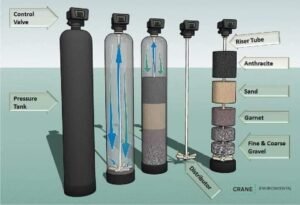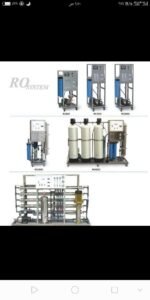Water treatment plants
The treatment units are an important part, due to the impossibility of entering raw water directly into the dialysis machines, as the dialysis machines may be affected by the water used in them by many of the obstacles and chemical and biological substances present in this water. Rather, dialysis centers require a certain quality of water before entering the dialysis units, and this awareness is obtained through treatment units.

In the treatment units, suspended matter is removed, water is softened, organic matter is separated, and some inorganic matter is removed, and organisms are removed for fear of attacking the reverse osmosis membranes. Water contains some dissolved air pollutants, and it carries with it various minerals such as silica, calcium, magnesium, iron and others, in addition to suspended particles and bacteria.
The treatment processes aim to maintain the integrity of the RO membranes for a long time while increasing their capacity by removing suspended matter, bacteria, fast-settling materials, colloidal materials and others.
Treatment units include water softening, coagulation, and filtration processes. Water hardness, suspended matter and other substances mentioned above are removed as follows:
Removal of suspended matter: This is done by coagulation and filtration. The coagulation process aims to facilitate the sedimentation and filtration of small-sized suspended materials using some chemicals such as alum (aluminum sulfate) and iron chloride, followed by the separation of suspended materials in different filters.
Water softener removal: By dissolving lime and soda ash, to prevent the deposition of calcium and magnesium salts, which are characterized by their extreme susceptibility to deposition on reverse osmosis membranes.
Organic matter removal: Activated carbon and some polymers are added. Chlorine is also used to oxidize organic materials and destroy living organisms. However, it is necessary to remove excess chlorine before pushing the water to the osmosis unit, since many reverse osmosis membranes oxidize with chlorine and their effectiveness decreases.
It is worth noting that the suspended substances and different salts are still one after another in separate processes. Country Concentrations of more than one substance may be reduced in one process. The above processes in primary treatment units serve more than one purpose at the same time.

Reverse osmosis units:
These units, compared to thermal desalination methods such as flash distillation or multi-stage distillation, have several advantages, the most important of which are the following:
- Low energy consumption used.
- The absence of corrosion problems and low sediment quantities.
- Short time to set up.
- Ease of operation and maintenance.
- Low cost and increased production of treated water.

RO units consist of a high pressure pump - a centrifugal pump or a positive displacement pump - and diaphragms and control and distribution devices.
Polyamide or cellulose acetate films: The first is characterized by its resistance to bacteria, while the second is characterized by high resistance to chlorine, and a good range of pH ranges between 2 to 8
Modified cellulose membranes: They have a high ability to retain salts up to 99% with a high rate of filtration (permeability) of fresh water estimated at about 6 to 12 liters of fresh water per day per square meter of membrane area and for every one atmospheric pressure in excess of the osmosis pressure. .
Composite membranes: It has a great ability to resist microorganisms (bacteria) and works for me in a wide range of pH, usually ranging from 2 to 12
Final processing:
The water is passed through ultraviolet sterilization, and then on micron candles with a porosity of 1 micron.
Bacteria-blocking plugs with narrow pores to block bacteria
Thus, the water becomes suitable for medical uses and dialysis operations
The energies of the units and their provisions vary according to the demand for the amount of water produced


